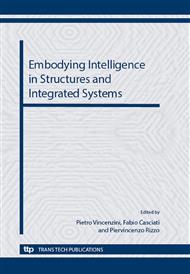[1]
F Sadek, B Mohraz, A.W. Taylor, R.M. Chung, Method of estimating the parameters of tuned mass dampers for seismic applications, Earthquake Engineering and Structural Dynamics. 26 (1997) 617-635.
DOI: 10.1002/(sici)1096-9845(199706)26:6<617::aid-eqe664>3.0.co;2-z
Google Scholar
[2]
C.C. Lin, J.M. Ueng, T.C. Huang, Seismic response reduction of irregular buildings using passive tuned mass dampers, Engineering Structures. 22 (2000) 513-524.
DOI: 10.1016/s0141-0296(98)00054-6
Google Scholar
[3]
S.V. Bakre, R.S. Jangid, Optimum parameters of tuned mass damper for damped main system, Structural Control and Health Monitoring. 14 (2007) 448-470.
DOI: 10.1002/stc.166
Google Scholar
[4]
C.C. Lin, J.F. Wang, J.M. Ueng, Vibration control identification of seismically-excited MDOF structure-PTMD systems, Journal of Sound and Vibration. 240 (2001) 87-115.
DOI: 10.1006/jsvi.2000.3188
Google Scholar
[5]
J.F. Wang, C.C. Lin, Seismic performance of multiple tuned mass dampers for soil-irregular building interaction systems, International Journal of Solids and Structures. 42 (2005) 5536-5554.
DOI: 10.1016/j.ijsolstr.2005.02.042
Google Scholar
[6]
J.F. Wang, C.C. Lin, C.H. Lien, Two-stage optimum design of tuned mass dampers with consideration of stroke, Structural Control and Health Monitoring. 16 (2009) 55-72.
DOI: 10.1002/stc.312
Google Scholar
[7]
T.T. Soong, B.F. Spencer, Supplemental energy dissipation: State of the art and state of the practice, Engineering Structures. 24 (2002) 243-259.
DOI: 10.1016/s0141-0296(01)00092-x
Google Scholar
[8]
C.C. Lin, J.F. Wang, B.L. Chen, Train-induced vibration control of high-speed railway bridges equipped with multiple tuned mass dampers, Journal of Bridge Engineering (ASCE). 10 (2005) 398-414.
DOI: 10.1061/(asce)1084-0702(2005)10:4(398)
Google Scholar
[9]
S. Zivanovic, A. Pavic, P. Reynolds, Vibration serviceability of footbridges under human-induced excitation: A literature review, Journal of Sound and Vibration. 279 (2005) 1-74.
DOI: 10.1016/j.jsv.2004.01.019
Google Scholar
[10]
M. Abe, Semi-active tuned mass dampers for seismic protection of civil structures, Earthquake Engineering and Structural Dynamics. 25 (1996) 743-749.
DOI: 10.1002/(sici)1096-9845(199607)25:7<743::aid-eqe579>3.0.co;2-s
Google Scholar
[11]
U. Aldemir, Optimal control of structures with semi-active tuned mass dampers, Journal of Sound and Vibration. 266 (2003) 847-874.
DOI: 10.1016/s0022-460x(03)00191-3
Google Scholar
[12]
C.S. Cai, W.J. Wu, M. Araujo, Cable vibration control with a TMD-MR damper system: experimental exploration, Journal of Structural Engineering (ASCE). 133 (2007) 629-637.
DOI: 10.1061/(asce)0733-9445(2007)133:5(629)
Google Scholar
[13]
C.C. Lin, G.L. Lin, J.F. Wang, Protection of seismic structures using semi-active friction TMD, Earthquake Engineering and Structural Dynamics. 39 (2010) 635-659.
DOI: 10.1002/eqe.961
Google Scholar
[14]
C.C. Lin, L.Y. Lu, G.L. Lin, T.W. Yang, Vibration control of seismic structures using semi-active friction multiple tuned mass dampers, Engineering Structures. 32 (2010) 3404-3417.
DOI: 10.1016/j.engstruct.2010.07.014
Google Scholar
[15]
G.L. Lin, C.C. Lin, L.Y. Lu, Y.B. Ho, Experimental verification of seismic vibration control using semi-active friction tuned mass damper, Earthquake Engineering and Structural Dynamics, 41 (2012) 813-830.
DOI: 10.1002/eqe.1162
Google Scholar
[16]
S. Nagarajaiah, E. Sonmez, Structures with semi-active variable stiffness single/multiple tuned mass dampers, Journal of Structural Engineering (ASCE); 133 (2007) 67-77.
DOI: 10.1061/(asce)0733-9445(2007)133:1(67)
Google Scholar
[17]
S. Nagarajaiah, Adaptive passive, semi-active, smart tuned mass dampers: Identification and control using empirical mode decomposition, Hilbert transform, and short-term Fourier transform, Structural Control and Health Monitoring. 16 (2009).
DOI: 10.1002/stc.349
Google Scholar
[18]
M.H. Chey, J.G. Chase, J.B. Mander, A.J. Carr, Semi-active tuned mass damper building systems: Design, Earthquake Engineering and Structural Dynamics. 39 (2010) 119-139.
DOI: 10.1002/eqe.934
Google Scholar
[19]
M.H. Chey, J.G. Chase, J.B. Mander, A.J. Carr, Semi-active tuned mass damper building systems: Application, Earthquake Engineering and Structural Dynamics. 39 (2010) 69-89.
DOI: 10.1002/eqe.933
Google Scholar
[20]
B.F. Spencer, S. Nagarajaiah, State of the art of structural control, Journal of Structural Engineering (ASCE). 129 (2003) 845-856.
DOI: 10.1061/(asce)0733-9445(2003)129:7(845)
Google Scholar
[21]
J.G. Chase et al, Re-shaping hysteretic behavior using semi-active resettable device dampers, Engineering Structures. 28 (2006) 1418-1429.
DOI: 10.1016/j.engstruct.2006.01.011
Google Scholar
[22]
J.N. Yang, J.H. Kim, A.K. Agrawal, Resetting semi-active stiffness damper for seismic response control, Journal of Structural Engineering (ASCE). 126 (2000) 1427-1433.
DOI: 10.1061/(asce)0733-9445(2000)126:12(1427)
Google Scholar
[23]
J.N. Yang, J. Bobrow, F. Jabbari, J. Leavitt, C.P. Cheng, P.Y. Lin, Full-scale experimental verification of resettable semi-active stiffness dampers, Earthquake Engineering and Structural Dynamics; 36 (2007) 1255-1273.
DOI: 10.1002/eqe.681
Google Scholar
[24]
S. Narasimhana, S. Nagarajaiah, A STFT semi-active controller for base isolated buildings with variable stiffness isolation systems, Engineering Structures. 27 (2005) 514-523.
DOI: 10.1016/j.engstruct.2004.11.010
Google Scholar
[25]
S. Nagarajaiah, S. Sahasrabudhe, Seismic response control of smart sliding isolated buildings using variable stiffness systems: An experimental and numerical study, Earthquake engineering and structural dynamics. 35 (2006) 177-197.
DOI: 10.1002/eqe.514
Google Scholar
[26]
L.Y. Lu, G.L. Lin, T.C. Kuo, Stiffness controllable isolation system for near-fault seismic isolation, Engineering Structures. 30 (2008) 747-765.
DOI: 10.1016/j.engstruct.2007.05.022
Google Scholar
[27]
L.Y. Lu, T.K. Lin, S.W. Yeh, Experiment and analysis of a leverage-type stiffness controllable isolation system for seismic engineering, Earthquake Engineering and Structural Dynamics. 39 (2010) 1711-1736.
DOI: 10.1002/eqe.1005
Google Scholar
[28]
T. Kobori, M. Takahashi, T. Nasu, N. Niwa, K. Ogasawara, Seismic response controlled structure with active variable stiffness system, Earthquake Engineering and Structural Dynamics. 22 (1993) 925-41.
DOI: 10.1002/eqe.4290221102
Google Scholar
[29]
L.Y. Lu, L.L. Chung, L.Y. Wu, G.L. Lin, Dynamic analysis of structures with friction devices using discrete-time state-space formulation, Computers and Structures. 84 (2006) 1049-1071.
DOI: 10.1016/j.compstruc.2005.12.005
Google Scholar
[30]
L.Y. Lu, G.L. Lin, Improvement of near-fault seismic isolation using a resettable variable stiffness damper, Engineering Structures. 31 (2009) 2097-2114.
DOI: 10.1016/j.engstruct.2009.03.011
Google Scholar
[31]
C.C. Lin, C.M. Hu, J.F. Wang, R.Y. Hu, Vibration control effectiveness of passive tuned mass dampers, Journal of the Chinese Institute of Engineers. 17 (1994) 367-376.
DOI: 10.1080/02533839.1994.9677600
Google Scholar
[32]
L.L. Chung, C.C. Lin, S. Y. Chu, Optimal direct output feedback of structural control, Journal of Engineering Mechanics (ASCE). 119 (1993): 2157-2173.
DOI: 10.1061/(asce)0733-9399(1993)119:11(2157)
Google Scholar
[33]
S.Y. Chu, C.C. Lin, L.L. Chung, C.C. Chang, K.H. Lu, Optimal performance of discrete-time direct output feedback structural control with delayed control forces, Structural Control and Health Monitoring. 5 (2008) 20-42.
DOI: 10.1002/stc.193
Google Scholar


